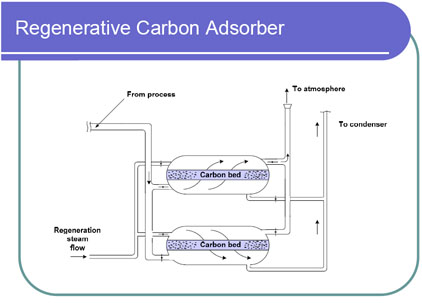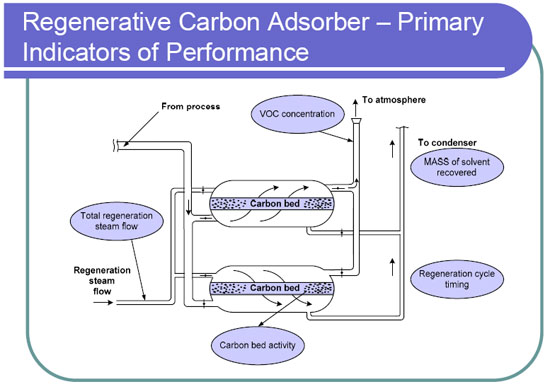Monitoring by Control Technique - Activated Carbon Adsorber
Description
In adsorption, gaseous pollutants are removed from an air stream by transferring the pollutants to the solid surface of an adsorbent. Activated carbon is the most commonly used adsorbent, although zeolites, polymers, and other adsorbents may be used. There is a limit to the mass of pollutants that can be collected by an adsorbent. When this limit is reached, the adsorbent is no longer effective in removing pollutant. To recover the ability to capture gaseous pollutants, adsorbents typically are "regenerated;" i.e., the pollutant is desorbed (removed) from the adsorbent. This regeneration may occur off-site or on-site.
The most common types of adsorber systems use fixed beds (as opposed to fluidized beds, or the moving beds that are common in concentrator systems). One type regenerates on site; the second type, called a carbon drum, uses off-site regeneration. Carbon drum systems are low-capital-cost systems, used only when air flow rates and mass flow rates of pollutants are low. Regeneration, either on-site or off-site, typically uses either elevated temperatures (i.e., thermal desorption, sometimes using steam) or below-atmospheric pressures (vacuum regeneration). In some cases the solvent recovered from desorption (e.g., toluene from publication rotogravure printing operations) is re-introduced into the process; in other cases, it is disposed.
Several types of capacity are important to adsorbers. Saturation capacity is the maximum capacity the adsorbent can hold. However, before saturation capacity is reached, the adsorbent reaches its breakthrough capacity, which is the amount of pollutant that can be adsorbed before a significant pollutant concentration exits, or breaks through, the bed. Heel capacity is the amount of pollutant that remains in the bed after it has been regenerated. Working capacity is the difference between breakthrough capacity and heel capacity, and represents the amount of material that can be adsorbed in each working cycle. A typical working capacity is 10-20 pounds of contaminant per 100 pounds of carbon.
Adsorption systems are usually limited to sources generating organic compounds having a molecular weight of more than 50 and less than approximately 200. Low molecular weight organics usually do not adsorb sufficiently. High molecular weight compounds adsorb so strongly that it is difficult to remove these materials from the adsorbent during the desorption cycle. These molecular weights are provided as a guideline, and the suitability of an adsorption system should be considered on a case-by-case basis.
For more information, see the box More About Carbon Adsorbers.
Monitoring Information
The primary indicators of the performance of carbon adsorbers are the adsorber outlet VOC concentration; regeneration parameters including regeneration cycle timing, total regeneration stream (steam or nitrogen) flow or the vacuum achieved during regeneration; and carbon bed activity sampling. Other indicators of adsorber performance include bed operating temperature, inlet gas temperature, gas flow rate, inlet VOC concentration, pressure differential, inlet gas moisture content, and leak check monitoring.
The Compliance Assurance Monitoring (CAM) Technical Guidance Document (TGD) provides a source of information on monitoring approaches for different types of control devices. Specific information provided in the CAM TGD related to carbon adsorption include example CAM submittals based on case studies of actual facilities. See the box More About Monitoring and the CAM Rule.
Costs
Costs of carbon adsorption are discussed in the EPA Air Pollution Control Cost Manual*, EPA/452/B-02-001, Section 3.1, Chapter 1 - Carbon Adsorbers (42 pp, 542 K, About PDF). Costs of monitoring systems, both Continuous Emission Monitors and parametric monitoring systems, are addressed in the EPA Air Pollution Control Cost Manual, EPA/452/B-02-001, Section 2, Chapter 4 - Monitors (42 pp, 542 K, About PDF).

- EPA Air Pollution Control Cost Manual*, EPA/452/B-02-001, Section 3.1, Chapter 1 - Carbon Adsorber (42 pp, 542 K, About PDF)
- EPA Technical Bulletin, EPA 456/F-99-004 - Choosing an Adsorption System for VOC: Carbon, Zeolite, or Polymers? (32 pp, 218 K, About PDF)
- Training Video - Air Pollution Control Devices - Carbon Adsorption (MP4) (zip)

- CAM Rule(48 pp, 408 K, About PDF) - Federal Register - October 22, 1997
- CAM TGD Appendix A: Example CAM Submittals for Carbon Adsorbers
